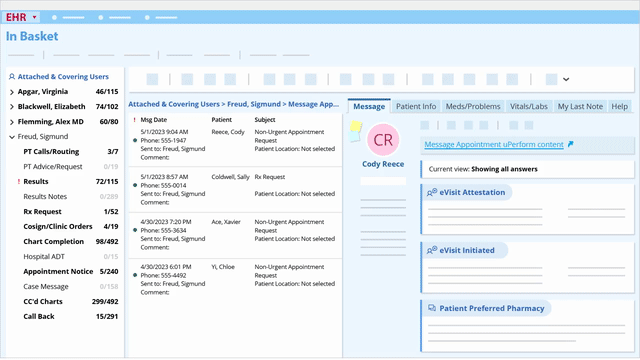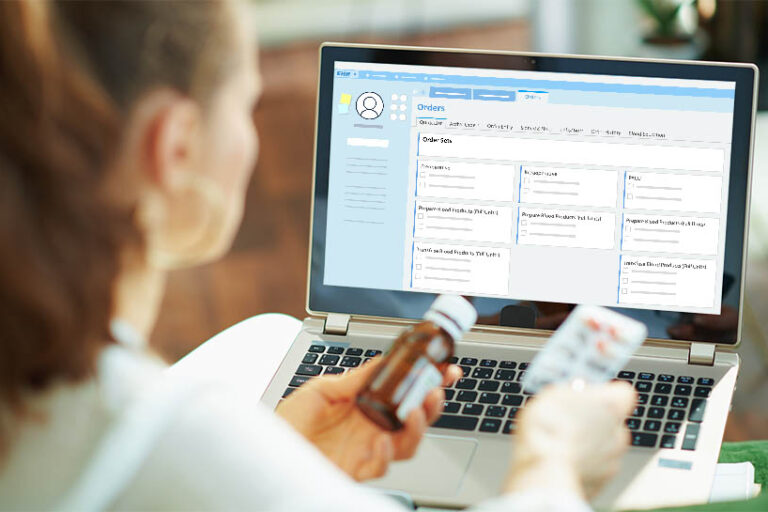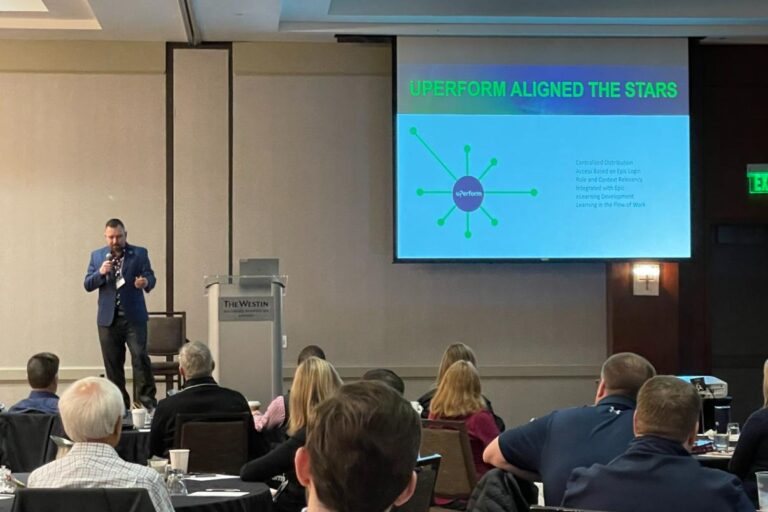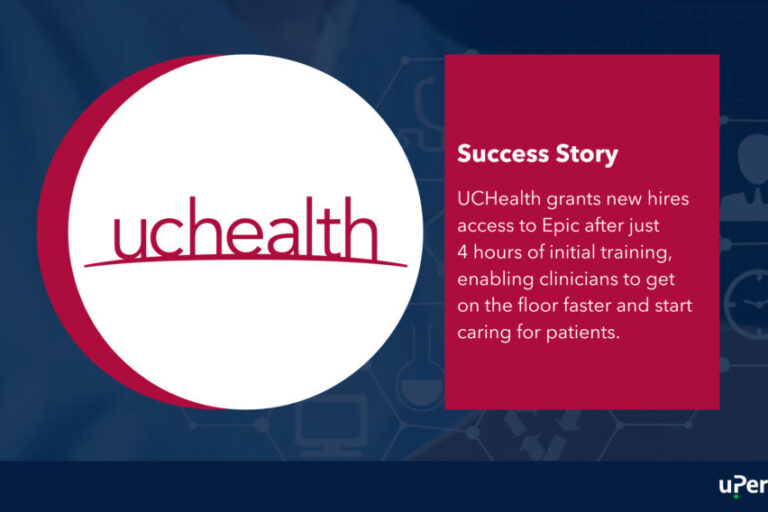Like anyone in healthcare IT, Dr. CT Lin and Terri Couts have both experienced their fair share of failure. But their shared commitment to finding solutions is what has earned them recognition as industry leaders today.
uPerform was honored with the opportunity to host Dr. Lin and Couts for a track session panel discussion at the CHIME23 Fall Forum. On the topic of supporting clinicians with strategies to reduce tech stress and improve efficiencies, they shared the missteps they’ve made along the way, strategies that have been successful and the value they’re seeing now.
About Dr. CT Lin
CT Lin, MD, FACP, FAMIA, serves as CMIO at UCHealth, one of CHIME’s Most Wired level 10 systems. Dr. Lin is also a Professor of Medicine at the University of Colorado and is board-certified in Internal Medicine and Clinical Informatics. His national awards include “Healthcare IT Innovator” and “Electronic Physician of the Year.” He is also an avid blogger and ukulele enthusiast. Follow his blog at The Undiscovered Country.
About Terri Couts
Terri Couts, RN-BC MHA, is the SVP and Chief Digital Officer at The Guthrie Clinic, one of only two healthcare organizations to achieve Epic® Gold Star Level 10 status in three consecutive years. Couts has dedicated her career to improving patient care through the use of technological initiatives and software optimization, for which she has received national awards and recognition.
The failure résumé: IT projects and classroom training
Neither Couts nor Dr. Lin shy away from discussing past failures regarding IT projects. Couts cautions against even calling such initiatives ‘IT projects,’ expressing that failure begins the moment you call them such. Instead, she prefers to think of them in terms of how they contribute to the organization’s mission to support patients.
She also notes the importance of training, referencing their implementation of Epic’s Blood Product Administration Module (BPAM). A lack of adequate training had wide-ranging impacts on the organization, including its ability to care for patients. After providing additional training, Guthrie was able to leverage the module effectively in its care delivery, but Couts adds that the initial failure has left a ‘black eye’ on the IT department.
Dr. Lin focuses less on the amount of training he and his team have delivered over the years, instead focusing on how they’ve delivered that training. In fact, his goal is to provide as little training as necessary, while still supporting clinicians.
He describes two ways in which he and his team have failed clinicians, and they aren’t unique to UCHealth. First, he reflects on how he and his team used to send out information about Epic upgrades by newsletter but notes that the read rate for the newsletter was in the single digits, emphasizing that means only one of ten staff members are informed of these changes.
The second failure he mentions is classroom training. He explains that everyone learns at different rates, and instructor-led classroom training always moves too slowly or too fast for any given individual. For Dr. Lin, that means 100% of learners are unhappy with the classroom model.
Building relationships: A key foundation for IT success
Both Dr. Lin and Couts emphasize the value of building relationships within the organization to ensure success with IT initiatives. It’s even a part of the vision statement for Dr. Lin’s team: “We improve physician and team wellness and effectiveness by building extraordinary relationships and innovative tools.”
One strategy UCHealth is using to improve the use of IT tools is what they call ‘sprint optimizations,’ in which members of Dr. Lin’s team spend two weeks with a clinical team and work with them to optimize their technology. He emphasizes that the focus on teamwork, as opposed to technology. It’s about building functional teamwork and integrating technology into that teamwork model.
For Couts, the importance of building relationships is exactly why she refuses to call these initiatives ‘IT projects.’ She believes IT leaders have a responsibility to think about how technology, and the use of that technology, impact the organization’s goal. To do this requires working with business and clinical teams to ensure the project is in alignment with departmental needs and messages are delivered successfully.
For training, sometimes less is more
Where new hires at UCHealth used to sit through 8 hours of classroom instruction as part of their onboarding, they now gain access to Epic and start seeing patients after only a few hours of onboarding, most of which is self-paced. Dr. Lin and UCHealth leverage uPerform to deliver self-paced learning to new hires, a strategy he says has worked well for both the training team and new hires.
- Tech setup: Trainers work with 4-6 new hires at a time to provide login access for applications. They ensure logins and two factor authentication are working and provide them access to their self-paced learning library.
- Self-paced onboarding: New hires are then able to work through their self-paced onboarding on their own time. UCHealth delivers this learning via workflow simulations created with uPerform. This allows new hires to get a hands-on education. The self-paced format allows them to take as long or as little time as they need, depending on their comfort level and experience with the software applications. After about three hours of self-paced onboarding, new hires are ready to start seeing patients.
- Advanced specialty training: New hires must return for an advanced specialty training session within seven days of completing their onboaridng. If they do not, they risk losing their access to Epic. Here, new hires work with trainers to set up and customize their workflows for greater efficiency.
- Pothole training: Finally, users go through what UCHealth calls ‘pothole’ training. The organization leverages Amplifire® to train users on the workflows and procedures where users most often run into trouble.
According to Dr. Lin, clinicians “strongly prefer” the self-paced learning model. It also provides instructional designers more time to develop content and offer one-on-one support to users who are struggling. Furthermore, UCHealth has been able to scale its training capacity to keep pace with organizational growth without having to add more members to the training team, something that would not have been possible with traditional classroom training.
Meeting users where they are
Perhaps the biggest lesson that Dr. Lin and Couts have learned through past failures is that successful IT initiatives must meet users wherever and whenever they are with quality training content. Both organizations are now leveraging uPerform to deliver content to users in their workflow.
Couts says it’s important to leverage multiple formats to deliver content. For her and her team, that still involves delivering content via email. But they also leverage Workplace, an application by Meta that is like Facebook but for the internal workforce. There, executive leaders (who are often still practicing caregivers) post ‘Did you know?’ videos and helpful tips for navigating IT tools. As mentioned, they also leverage uPerform to deliver in-application help within Epic.
UCHealth is also leveraging uPerform to develop in-application help. In fact, they’ve been working with uPerform to expand its integration capabilities and make the access points to help content even more seamless for users. Dr. Lin describes this strategy as “putting the road signs on the road,” as opposed to in the garage. For example, UCHealth has been able to embed a link to support content directly in their Message Appointments workflow.
For Couts and Dr. Lin, successfully delivering IT solutions to users is about learning from past mistakes, building relationships and meeting users at their time and place of need. And for Guthrie and UCHealth, the value of prioritizing caregivers’ time and needs by investing in better IT training and communications has been immeasurable.
Related Articles
Meet your users where they are with uPerform
Looking for a more efficient way to deliver IT solutions and communications over the last mile to clinicians? uPerform arms training teams with the tools they need to quickly create effective learning content in a variety of formats and deliver it to users at their time and place of need within your most critical software applications.
Contact us today to schedule a demo and learn more about how uPerform can help support your users from initial onboarding to ongoing training.











